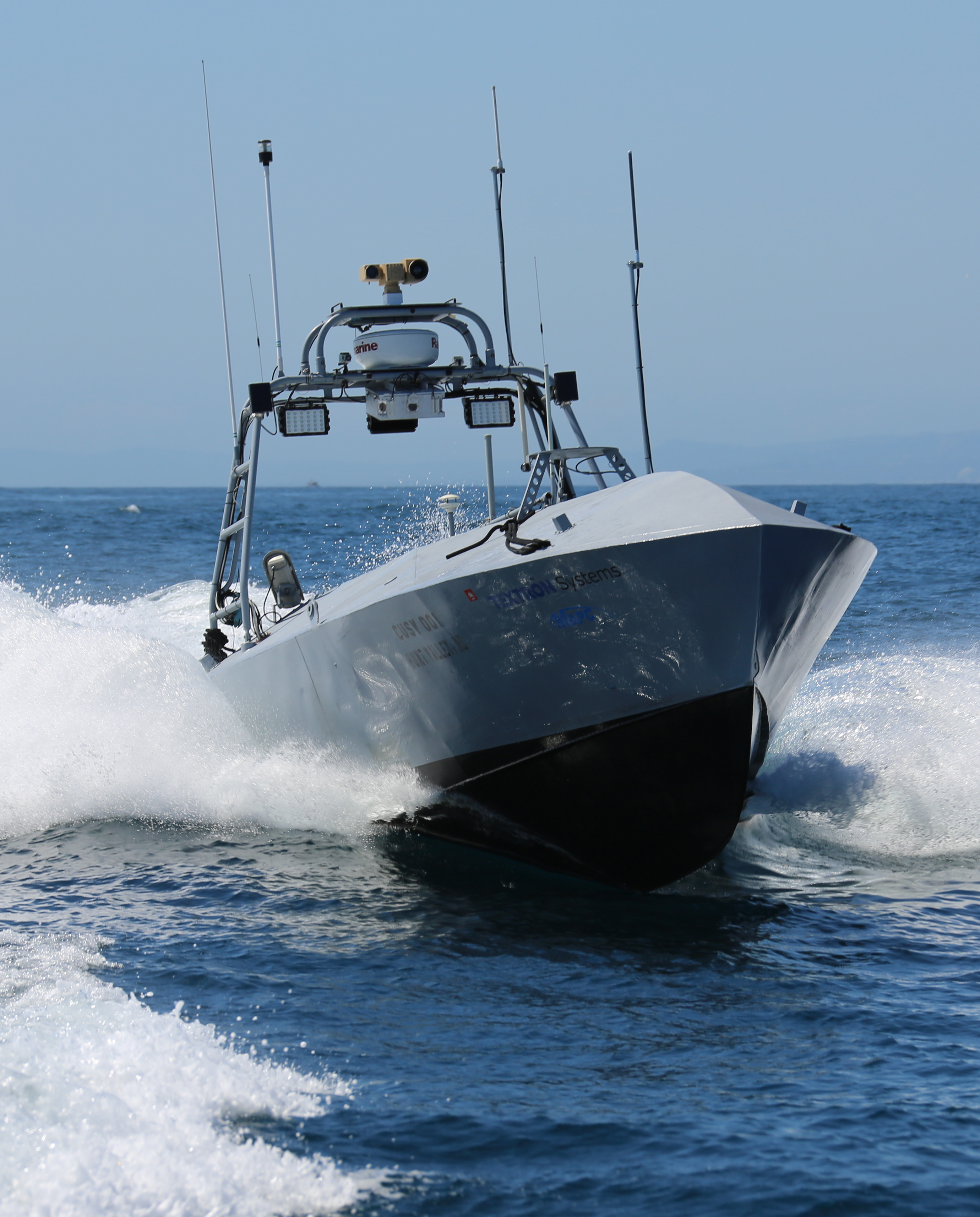
Textron’s Common Unmanned Surface Vehicle (CUSV) program has moved into the production phase and will begin delivering its minesweeping capability to the fleet by early next year, even as the program is also situating itself to enter the minehunting, patrolling and other surface warfare mission areas.
CUSV (pronounced: Cuss-Vee) , which was created in 2009 and was selected in October 2014 to carry the Navy’s Unmanned Influence Sweep System for the Littoral Combat Ship’s mine countermeasures mission (MCM) package, completed its critical design review in November and moved into production shortly after, Textron Vice President for Control and Surface Systems Wayne Prender told USNI News in a Jan. 13 interview.
Prender said 11-meter unmanned surface boat will be built in Textron’s Slidell, La., shipyard, the command and control system and minesweeping payload will be built in the Hunt Valley, Md., facility, and the two will be integrated in Louisiana. CUSV will go through land-based and then water-based testing in mid-2016, and the first vehicle should deliver in late 2016 or early 2017.
The first CUSVs will carry the minesweeping payload, which Prender said is is “based off a Navy design but we are designing some modifications to that and we are procuring it, so it’s not government furnished” equipment. The Navy’s influence sweep system will be towed behind the unmanned vehicle and will emit sounds and magnetic signatures that mimic a ship – setting off nearby mines that listen for passing ships.
The addition of the CUSV with the minesweeper to the LCS MCM mission package will create Increment 3. Increment one includes the helicopter-deployed airborne laser mine detection system (ALMDS), the mine-killing airborne mine neutralization system (AMNS), and the Remote Multimission Vehicle (RMMV) towing an AQS-20A sonar for mine hunting. Increment 2 adds the coastal battlefield reconnaissance and analysis system (COBRA) for beach zone mine detection.
The RMMV, however, has experienced reliability problems throughout the last decade and has been the subject of increased scrutiny since the LCS MCM mission package initial operational test and evaluation (IOT&E) was called off over the summer due to continued reliability problems with both RMMV and other components of the ship.
On Aug. 31, Senate Armed Services Committee chairman John McCain (R-Ariz.) and ranking member Jack Reed (D-R.I.) wrote a letter to Navy and Pentagon leadership asking that the Navy “review the alternatives and make sure we are on the correct course, rather than letting the inertia of the status quo continue the program of record on into operational testing and production.”
An independent review team was set up in October and has not yet released its recommendations on a path forward.

If the Navy were to pursue an alternative to RMMV, CUSV may be an attractive option. The unmanned vehicle itself is already part of the MCM mission package, and therefore LCS sailors would be trained to maintain it and spare parts would be on the ship. And Textron is also already working with the Navy on a mine hunting payload for the CUSV for operations off the Expeditionary Transfer Dock. Prender said Textron started working on the mine hunting payload a few years ago, when the Defense Department announced an urgent operational need for unmanned mine hunting vehicles for use in U.S. 5th Fleet. Prender said there are several vehicles operating in and around Bahrain today, but “CUSV is a target to come in and provide that same kind of service.”
Textron recently tested the CUSV from an Expeditionary Transfer Dock, which could be used to launch unmanned vehicles from the sea.
“In addition to this being a mission module on LCS, we’re also working to show that this platform can be deployed from various host ships,” Prender said.
“So in the fall time of 2015, this boat was deployed out to San Diego on the [USNS] John Glenn – used to be called the Mobile Landing Platform, now it’s the Expeditionary Transfer Dock. So we went out there, we set up in expeditionary fashion, with the small footprint standalone ground station and our vehicle, and then we deployed off of the [USNS] John Glenn – they picked us up with their crane, put us in the water. We did some basic maneuver operations around the USS John Glenn to kind of prove the concept. Then we recovered, we did that numerous times to kind of showcase that it can be used wherever, whenever.”
Prender said the CUSV has a modular, open design to accommodate whatever new payloads the Navy is interested in. Though Prender could not discuss upcoming awards, he said “we’re pretty close with the Navy on some additional next steps, so we’ll wait until those contracts are officially awarded. … Certainly the Navy has a roadmap (for CUSV) and sweeping was the first, what they call the first flight, the first mission package that they wanted CUSV to tow. The second one that they want is mine hunting, so that will be the side-scan sonar payload package, that will probably be the most immediate next payload.”
With internal research and development dollars, Textron has also looked at using CUSV for intelligence, surveillance and reconnaissance (ISR), border patrol, communications relay and security missions for the military, as well as ways to get into the commercial market in industries such as oil and gas.





